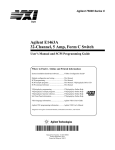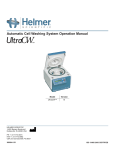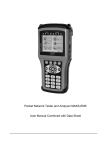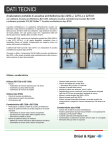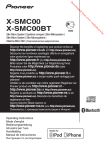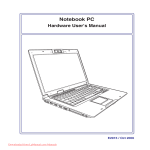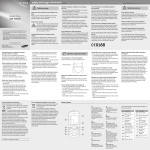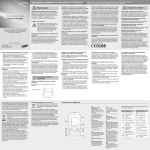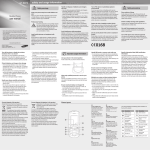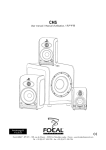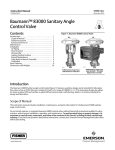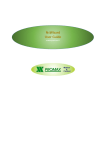Download UltraCW Automatic Cell Washing System Service Manual
Transcript
TM Automatic Cell Washing System Service Manual UltraCW™ Version B Model UltraCW™ S/N HELMER SCIENTIFIC • 14400 BERGEN BOULEVARD • NOBLESVILLE, IN 46060 USA PHONE +1.317.773.9073 • FAX +1.317.773.9082 USA and CANADA 800.743.5637 www.helmerinc.com 360113-1/E Contents Contents About this manual. . . . . . . . . . . . . . . . . . . . . . . . . . . . . . . . . . . . . . . . . . . . . . . . . . . . . . . . . . . ii 1 Working safely. . . . . . . . . . . . . . . . . . . . . . . . . . . . . . . . . . . . . . . . . . . . . . . . . . . . . . . . . . . 1 1.1 1.2 1.3 General safety. . . . . . . . . . . . . . . . . . . . . . . . . . . . . . . . . . . . . . . . . . . . . . . . . . . . . . . . . . . . . . . . . . . . 1 Electrical safety. . . . . . . . . . . . . . . . . . . . . . . . . . . . . . . . . . . . . . . . . . . . . . . . . . . . . . . . . . . . . . . . . . . 1 Chemical and biological safety . . . . . . . . . . . . . . . . . . . . . . . . . . . . . . . . . . . . . . . . . . . . . . . . . . . . . . . 1 2 Reviewing information about your cell washer. . . . . . . . . . . . . . . . . . . . . . . . . . . . . . . . . 2 2.1 2.2 Finding model and input power information. . . . . . . . . . . . . . . . . . . . . . . . . . . . . . . . . . . . . . . . . . . . . . 2 Finding software and part version information. . . . . . . . . . . . . . . . . . . . . . . . . . . . . . . . . . . . . . . . . . . . 2 3Troubleshooting. . . . . . . . . . . . . . . . . . . . . . . . . . . . . . . . . . . . . . . . . . . . . . . . . . . . . . . . . . 3 3.1 3.2 Troubleshooting general operation problems. . . . . . . . . . . . . . . . . . . . . . . . . . . . . . . . . . . . . . . . . . . . . 3 Addressing error messages. . . . . . . . . . . . . . . . . . . . . . . . . . . . . . . . . . . . . . . . . . . . . . . . . . . . . . . . . . 4 4 Servicing the cell washer . . . . . . . . . . . . . . . . . . . . . . . . . . . . . . . . . . . . . . . . . . . . . . . . . 15 4.1 4.2 4.3 4.4 4.5 4.6 4.7 4.8 4.9 4.10 Testing whether the rotor speed is within the design tolerance. . . . . . . . . . . . . . . . . . . . . . . . . . . . . . 15 Testing whether the imbalance value is in the permissible range . . . . . . . . . . . . . . . . . . . . . . . . . . . . 16 Adjusting the imbalance microswitch. . . . . . . . . . . . . . . . . . . . . . . . . . . . . . . . . . . . . . . . . . . . . . . . . . 17 Removing and installing the front panel. . . . . . . . . . . . . . . . . . . . . . . . . . . . . . . . . . . . . . . . . . . . . . . . 18 Adjusting the display contrast . . . . . . . . . . . . . . . . . . . . . . . . . . . . . . . . . . . . . . . . . . . . . . . . . . . . . . . 19 Viewing and changing the fill speed. . . . . . . . . . . . . . . . . . . . . . . . . . . . . . . . . . . . . . . . . . . . . . . . . . . 20 Replacing the frequency converter . . . . . . . . . . . . . . . . . . . . . . . . . . . . . . . . . . . . . . . . . . . . . . . . . . . 21 Removing and installing the bowl assembly . . . . . . . . . . . . . . . . . . . . . . . . . . . . . . . . . . . . . . . . . . . . 23 Performing post-repair checks. . . . . . . . . . . . . . . . . . . . . . . . . . . . . . . . . . . . . . . . . . . . . . . . . . . . . . . 25 Reviewing the preventive maintenance schedule. . . . . . . . . . . . . . . . . . . . . . . . . . . . . . . . . . . . . . . . 26 5 Parts . . . . . . . . . . . . . . . . . . . . . . . . . . . . . . . . . . . . . . . . . . . . . . . . . . . . . . . . . . . . . . . . . . 27 5.1 Parts on the front and lid. . . . . . . . . . . . . . . . . . . . . . . . . . . . . . . . . . . . . . . . . . . . . . . . . . . . . . . . . . . 27 5.2 Parts on the rear and bottom. . . . . . . . . . . . . . . . . . . . . . . . . . . . . . . . . . . . . . . . . . . . . . . . . . . . . . . . 28 5.3 Parts on the side . . . . . . . . . . . . . . . . . . . . . . . . . . . . . . . . . . . . . . . . . . . . . . . . . . . . . . . . . . . . . . . . . 28 5.4 Parts on the bowl and rotor. . . . . . . . . . . . . . . . . . . . . . . . . . . . . . . . . . . . . . . . . . . . . . . . . . . . . . . . . 29 5.5 Parts behind the front panel. . . . . . . . . . . . . . . . . . . . . . . . . . . . . . . . . . . . . . . . . . . . . . . . . . . . . . . . . 30 5.6 Parts behind the rear panel. . . . . . . . . . . . . . . . . . . . . . . . . . . . . . . . . . . . . . . . . . . . . . . . . . . . . . . . . 31 5.7 Parts under the bowl . . . . . . . . . . . . . . . . . . . . . . . . . . . . . . . . . . . . . . . . . . . . . . . . . . . . . . . . . . . . . . 32 5.8Accessories. . . . . . . . . . . . . . . . . . . . . . . . . . . . . . . . . . . . . . . . . . . . . . . . . . . . . . . . . . . . . . . . . . . . . 34 6Schematic. . . . . . . . . . . . . . . . . . . . . . . . . . . . . . . . . . . . . . . . . . . . . . . . . . . . . . . . . . . . . . 35 360113-1/E i About this manual About ii Welcome to the UltraCW™ Automatic Cell Washing System Service Manual. This section explains the symbols and conventions used in this manual, copyright information about this document, and trademark information for products supplied by Helmer. Intended audience This manual is intended for use by end users of the UltraCW cell washing system and authorized service technicians. This manual is to be used in conjunction with the UltraCW™ Automatic Cell Washing System Operation Manual. Symbols and conventions Several symbols and conventions are used in this manual. Cautions A Caution is used to call attention to a condition or possible situation that could damage or destroy the equipment or the operator’s work. Sample caution identified as follows: ! CAUTION Be sure that the tubing is free of obstructions. Blocked tubing can cause fluid to back up and cause motor failure. Notes Notes contain additional information about a topic. Notes are used to provide information about how a topic relates to another topic, or background information about a design characteristic. Sample note identified as follows: NOTE Tubing kits are available for purchase through Helmer. Model references Generic references are used throughout this manual to group models that contain similar features. For example, “UltraCW” refers to both the 115 V and 230 V models. If a feature or procedure applies to a specific voltage, it is stated as such. Copyright and trademark information Copyright © 2013 Helmer, Inc. UltraCW™ is a registered trademark of Helmer, Inc. in the United States of America. All other trademarks and registered trademarks are the property of their respective owners. Helmer, Inc., doing business as (DBA) Helmer Scientific and Helmer. 360113-1/E 1 Working safely Working safely 1 This section describes general safety information for servicing the UltraCW Automatic Cell Washing System (“cell washer”). The Operation Manual includes additional safety information for operating and cleaning the cell washer. Your organization may provide additional safety information. 1.1 General safety To avoid injury to yourself and the cell washer, follow these safety instructions: ► Do not use the cell washer if its components are damaged. ► Never attempt to physically restrict any of the moving components. ► Do not move or bump the cell washer during operation. ► Before performing the procedures in this manual, review the specific safety instructions for them. ► Before using tools, materials, and equipment to perform procedures in this manual, review the manufacturer’s safety instructions for them. ► Perform only the maintenance described in this manual. Maintenance other than that specified in this manual should only be performed by technical service representatives authorized by Helmer. 1.2 Electrical safety ! CAUTION The cell washer has the potential of being a shock hazard. Review all safety instructions. Review the following safety instructions before troubleshooting, repairing, or replacing parts in the cell washer: ► Before removing covers from the cell washer, disconnect the power to the cell washer. ► Use appropriate grounding precautions when replacing circuit boards and other electrical parts. ► Use power cords and other electrical parts that are designed for use with the cell washer. 1.3 Chemical and biological safety Review the safety instructions in the Operation Manual before using, cleaning, or servicing the cell washer. ! CAUTION ► In addition to the instructions included in this manual and the Operation Manual, follow all chemical handling and disposal requirements and procedures specified by your organization. ► Before sending parts to Helmer or your distributor for service or repair, decontaminate them as appropriate. Any items that have not been decontaminated appropriately will not be accepted. Documentation stating that the contents are not contaminated and are safe to handle must accompany all returns. Contact Helmer or your distributor for decontamination instructions and a return authorization number. 360113-1/E 2 Reviewing information about your cell washer Reviewing information about your cell washer 2 This section explains how to find identification information about your cell washer. 2.1 Finding model and input power information The Product Specification label is located on the right side of the cell washer next to the power connector. A Type: UltraCW B Serial Number 0000000 C Volts 110-127Vac Freq 60 Hz Kinetic Energy 250Nm Amps 2.5 Power Noblesville, IN USA www.helmerinc.com 200 Watts Max. Density 1.2Kg/dm3 2013 RPM 3500R/min Made in Switzerland Product Specification label (sample) Label A B C 2.2 Description Type (Model) Serial number (S/N) Power requirements Finding software and part version information The software version appears on the control panel when you turn on the power. Additional information is available through the Global menu, as follows: Parameter CONTROL: XXX h VERS XX °C/* 00 FU/CCI - 1001 FU/CCI - S. XX.XX Meaning Number of operating hours XX is the software version Frequency converter type Frequency converter software version To view version information in the Global menu 1 On the control panel, press and hold the parameter selection button () for about eight seconds until VOLUME ADJUST XX appears on the message screen. 2 Press and release the parameter selection button () to cycle through the global parameters. 3 Exit the Global menu by pressing the STOP button or by not pressing any of the buttons for approximately 16 seconds. The message screen returns to display mode for the selected program. 360113-1/E 3Troubleshooting Troubleshooting 3 Before taking actions as described in this section, make sure that operational issues have been addressed as described in the Operation Manual. Also, be sure that the cell washer operator has followed the appropriate laboratory procedures and used the appropriate materials for the task. This section describes some problems you may experience, explains possible causes, and provides actions you can take to correct them. ! 3.1 CAUTION Review all safety instructions prior to completing troubleshooting recommendations. For more information, see Section 1, “Working safely.” Troubleshooting general operation problems Problem The cell washer is turned on, but nothing is displayed on the message screen. Possible Cause There is no power to the cell washer. The display contrast is set too low. During a saline check, the pump is not making any sound and saline is not being dispensed. During a saline check, the pump is operating, but saline is not being dispensed correctly. The tubes were not decanted when they were programmed to do so. Action 1 Verify that the outlet is operational. 2 Try the following tasks in order, testing after each to determine if it solved the problem: a Replace the fuse. b Replace the main power switch. c Replace the transformer. d Replace the RFI filter. ► Adjust the display contrast. For instructions, see Section 4.5, “Adjusting the display contrast.” A part in the LCD circuit ► Try the following tasks in order, testing after each to is faulty. determine if it solved the problem: 1 Replace the control panel. 2 Replace the power supply board. A part in the pump ► Remove the pump tubing from the pump. With the system is faulty. pump tubing removed, perform a saline check. ► If the pump does not operate, replace the pump. ► If the pump does operate, replace the pump tubing, which may have hardened over time. A part in the liquid ► Try the following tasks in order, testing after each to handling system circuit determine if it solved the problem: is faulty. 1 Replace the flow meter. 2 Replace the liquid handling board. The rotor is faulty. ► Verify that all the rotor locks (decant hooks) are intact. If any are broken off or damaged, replace the rotor. A part in the motor ► Try the following tasks in order, testing after each to circuit is faulty. determine if it solved the problem: 1 Replace the motor. 2 Replace the frequency converter. For instructions, see Section 4.7, “Replacing the frequency converter.” 3 Replace the power supply board. 360113-1/E Troubleshooting Problem Possible Cause The rotor speed seems to A part in the speed be too high or too low. sensor circuit is faulty. Tubes are breaking during processes with a Decant step. 3.2 4 Action 1 Measure the rotor speed. For instructions, see Section 4.1, “Testing whether the rotor speed is within the design tolerance.” 2 Try the following tasks in order, testing after each to determine if it solved the problem: a Replace the speed sensor. b Replace the motor. c Replace the frequency converter. For instructions, see Section 4.7, “Replacing the frequency converter.” Tube holder inserts were ► Install the tube holder inserts, and repeat the process to not installed correctly determine if the problem was solved. before processing 10 mm x 75 mm tubes. The top of the tube does ► Ensure that the height of the tubes is within the not move freely around acceptable tolerance of 75 mm ± 1.5 mm. the fill port. Addressing error messages In the event of an error condition, the cell washer displays an error message to assist in troubleshooting. This section provides possible causes associated with each error message and actions that should be taken. XX represents the error message number. CONTROL - ERROR XX When a message of this type appears, there is a problem with the lid closing or locking, or a problem with the control panel. Error Possible cause message number 04, The lid lock is faulty. 06 to 09 Action 1 Clear the error message: Open the lid, then turn off the power. After about 10 seconds, turn the power back on. 2 Check if the lid can be opened while the cell washer is turned off. If it can, replace the lid lock. A connection in the lid lock circuit is loose. 1 Clear the error message: Open the lid, then turn off the power. After about 10 seconds, turn the power back on. 2 Check the contact connection between the lid lock and the control/display board. 3 Check that the ribbon cable between the control/ display board and the power supply board is securely connected. A part in the lid lock circuit is faulty. 1 Clear the error message: Open the lid, then turn off the power. After about 10 seconds, turn the power back on. 2 Try the following tasks in order, testing after each to determine if it solved the problem: a Replace the ribbon cable between the control/ display board and the power supply board. b Replace the power supply board. c Replace the control panel. 360113-1/E Troubleshooting Error Possible cause message number 21 to 26 The control panel is faulty. Action 1 Clear the error message: Open the lid, then turn off the power. After about 10 seconds, turn the power back on. 2 Replace the control panel. FU/CCI - ERROR XX When a message of this type appears, there is a problem related to the frequency converter. Error Possible cause message number 60 A part in the frequency converter circuit is faulty, resulting in a false lid lock release signal. Action ► Try the following tasks in order, testing after each to determine if it solved the problem: 1 Replace the ribbon cable between the control/ display board and the power supply board. 2 Replace the ribbon cable between the frequency converter and the power supply board. 3 Replace the frequency converter. For instructions, see Section 4.7, “Replacing the frequency converter.” 4 Replace the power supply board. 5 Replace the control panel. 61 A part in the frequency converter circuit is faulty, resulting in a processing error. 62 The main supply voltage is too low, 1 Clear the error message: Open the lid, then turn off the resulting in an undervoltage condition power. After about 1 minute, turn the power back on. to the frequency converter. 2 Verify that the outlet in the facility is operational and supplying adequate voltage to the cell washer. 3 Try the following tasks in order, testing after each to determine if it solved the problem: a Replace the ribbon cable between the control/ display board and the power supply board. b Replace the ribbon cable between the frequency converter and the power supply board. c Replace the frequency converter. For instructions, see Section 4.7, “Replacing the frequency converter.” d Replace the power supply board. e Replace the control panel. 1 Clear the error message: Open the lid, then turn off the power. After about 1 minute, turn the power back on. 2 Try the following tasks in order, testing after each to determine if it solved the problem: a Replace the ribbon cable between the control/ display board and the power supply board. b Replace the ribbon cable between the frequency converter and the power supply board. c Replace the frequency converter. For instructions, see Section 4.7, “Replacing the frequency converter.” d Replace the power supply board. e Replace the control panel. 360113-1/E 5 Troubleshooting Error Possible cause message number 63 A part in the frequency converter circuit is faulty, resulting in an overcurrent condition in the motor. Action 1 Clear the error message: Open the lid, then turn off the power. After about 1 minute, turn the power back on. 2 Try the following tasks in order, testing after each to determine if it solved the problem: a Replace the motor. b Replace the ribbon cable between the frequency converter and the power supply board. c Replace the frequency converter. For instructions, see Section 4.7, “Replacing the frequency converter.” d Replace the power supply board. 64 A part in the frequency converter circuit is faulty, resulting in an overvoltage condition in the braking resistor. 1 Clear the error message: Open the lid, then turn off the power. After about 1 minute, turn the power back on. 2 Try the following tasks in order, testing after each to determine if it solved the problem: a Replace the braking resistor. b Replace the ribbon cable between the frequency converter and the power supply board. c Replace the frequency converter. For instructions, see Section 4.7, “Replacing the frequency converter.” d Replace the power supply board. 67 A part in the frequency converter circuit is faulty, resulting in an overtemperature condition in the motor. 1 Clear the error message: Open the lid, then turn off the power. After about 1 minute, turn the power back on. 2 Try the following tasks in order, testing after each to determine if it solved the problem: a Test the motor windings. If they are faulty, replace the motor. b Replace the ribbon cable between the frequency converter and the power supply board. c Replace the frequency converter. For instructions, see Section 4.7, “Replacing the frequency converter.” d Replace the power supply board. 68 A part in the frequency converter circuit is faulty, resulting in an overvoltage condition in the frequency converter. 1 Clear the error message: Open the lid, then turn off the power. After about 1 minute, turn the power back on. 2 Confirm that the ambient temperature during operation does not exceed 45 °C. 3 Try the following tasks in order, testing after each to determine if it solved the problem: a Replace the ribbon cable between the control/ display board and the power supply board. b Replace the ribbon cable between the frequency converter and the power supply board. c Replace the frequency converter. For instructions, see Section 4.7, “Replacing the frequency converter.” d Replace the power supply board. 360113-1/E 6 Troubleshooting Error Possible cause message number 69 The frequency converter is faulty. Action 1 Clear the error message: Open the lid, then turn off the power. After about 1 minute, turn the power back on. 2 Replace the frequency converter. For instructions, see Section 4.7, “Replacing the frequency converter.” 84 A part in the frequency converter circuit is faulty, resulting the frequency converter detecting excess rotor speed. ► Try the following tasks in order, testing after each to determine if it solved the problem: 1 Replace the ribbon cable between the frequency converter and the power supply board. 2 Replace the frequency converter. For instructions, see Section 4.7, “Replacing the frequency converter.” 3 Replace the power supply board. 85 A part in the frequency converter circuit is faulty, resulting in a processing error. 1 Clear the error message: Open the lid, then turn off the power. After about 10 seconds, turn the power back on. 2 Try the following tasks in order, testing after each to determine if it solved the problem: a Replace the ribbon cable between the frequency converter and the power supply board. b Replace the frequency converter. For instructions, see Section 4.7, “Replacing the frequency converter.” c Replace the power supply board. 360113-1/E 7 Troubleshooting 8 IMBALANCE When this message appears, there is a problem with the balance of the rotor. Error Possible cause message number None The Imbalance initialization parameter was set to the wrong value after the frequency converter was replaced. None Action 1 Clear the error message: Open the lid, then turn off the power. After about 10 seconds, turn the power back on. 2 Check that the Imbalance parameter is set to 2. For more information and instructions, see Section 4.7 “Replacing the frequency converter.” The imbalance tolerance is set too low. 1 Clear the error message: Open the lid, then turn off the power. After about 10 seconds, turn the power back on. 2 Check the imbalance tolerance and adjust it if necessary. For instructions, see Section 4.2, “Testing whether the imbalance value is in the permissible range.” One or more motor mounts is worn. 1 Clear the error message: Open the lid, then turn off the power. After about 10 seconds, turn the power back on. 2 Check the motor mounts for wear. Replace them if necessary. A connection in the imbalance microswitch circuit is loose. 1 Clear the error message: Open the lid, then turn off the power. After about 10 seconds, turn the power back on. 2 Check the connection between the imbalance microswitch and the power supply board. 3 Check that the ribbon cable between the control/ display board and the power supply board is securely connected. A part in the imbalance microswitch circuit is faulty 1 Clear the error message: Open the lid, then turn off the power. After about 10 seconds, turn the power back on. 2 Try the following tasks in order, testing after each to determine if it solved the problem: a Check the continuity of the imbalance microswitch, which is normally closed. The resistance should be 0 Ω when the switch is closed (not activated). If there is resistance, replace the imbalance microswitch, then set the imbalance tolerance. For instructions, see Section 4.3, “Adjusting the imbalance microswitch.” b Replace the ribbon cable between the control/ display board and the power supply board. c Replace the power supply board. d Replace the control panel. 360113-1/E Troubleshooting LOW SALINE When this message appears, there is a problem with the flow of saline into the cell washer. Error Possible cause message number None A connection in the liquid handling system circuit is loose. Action 1 Clear the error message: Open the lid, then turn off the power. After about 10 seconds, turn the power back on. 2 Check the connection between the liquid handling board and the power supply board. A part in the pump system is faulty. 1 Clear the error message: Open the lid, then turn off the power. After about 10 seconds, turn the power back on. 2 Remove the pump tubing from the pump. With the pump tubing removed, perform a saline check. ► If the pump does not operate, replace the pump. ► If the pump does operate, replace the pump tubing, which may have hardened over time. A part in the liquid handling system circuit is faulty. 1 Clear the error message: Open the lid, then turn off the power. After about 10 seconds, turn the power back on. 2 Try the following tasks in order, testing after each to determine if it solved the problem: a Replace the flow meter. b Replace the liquid handling board. 360113-1/E 9 Troubleshooting 10 N > MAX XX When this message appears, the rotor speed being detected exceeds the maximum allowable speed. Error Possible cause message number 05 The insulation on the speed sensor cable is faulty. Action 1 Clear the error message: Turn off the power. After about 10 seconds, turn it back on. 2 Check the speed sensor cable for wear. If worn, replace the speed sensor. A connection in the speed sensor circuit is loose. 1 Clear the error message: Turn off the power. After about 10 seconds, turn it back on. 2 Check the connection between the speed sensor and the power supply board. 3 Check that the ribbon cable between the control/ display board and the power supply board is securely connected. A part in the speed sensor circuit is faulty. 1 Clear the error message: Turn off the power. After about 10 seconds, turn it back on. 2 Try the following tasks in order, testing after each to determine if it solved the problem: a Test the speed sensor by measuring the rotor speed. For instructions, see Section 4.1, “Testing whether the rotor speed is within the design tolerance.” If the speed is not within the tolerance, replace the speed sensor. b Replace the ribbon cable between the control/ display board and the power supply board. c Replace the ribbon cable between the frequency converter and the power supply board. d Replace the frequency converter. For instructions, see Section 4.7, “Replacing the frequency converter.” e Replace the power supply board. f Replace the control panel. 360113-1/E Troubleshooting 11 N < MIN XX When this message appears, the rotor is rotating too slowly. Error Possible cause message number 13 A connection in the motor circuit is loose. Action 1 Clear the error message: Open the lid, then turn off the power. After about 10 seconds, turn the power back on. 2 Check the connection between the motor and the frequency converter. A part in the motor circuit is faulty. 1 Clear the error message: Open the lid, then turn off the power. After about 10 seconds, turn the power back on. 2 Try the following tasks in order, testing after each to determine if it solved the problem: a Test the motor windings. If they are faulty, replace the motor. b Replace the frequency converter. For instructions, see Section 4.7, “Replacing the frequency converter.” The silicone motor seal is loose. 1 Clear the error message: Open the lid, then turn off the power. After about 10 seconds, turn the power back on. 2 Check that the motor seal has been installed properly. For more information, see Section 4.8, “Removing and installing the bowl assembly.” POWER INTERRUPT When this message appears, the AC power was interrupted during operation, or was sensed as being interrupted. Error Possible cause message number None A connection between the control/ display board and the power supply board is loose. A part in the control panel and power supply circuit is faulty. Action 1 Clear the error message: Open the lid then press the START WASH button. 2 Check the connection between the control/display board and the power supply board. 1 Clear the error message: Open the lid then press the START WASH button. 2 Try the following tasks in order, testing after each to determine if it solved the problem: a Replace the power supply board. b Replace the ribbon cable between the control/ display board and the power supply board. c Replace the control panel. 360113-1/E Troubleshooting 12 SER I/O - ERROR XX When a message of this type appears, there is a problem with communication between components. Error Possible cause message number 30 and 31 A connection in the frequency converter circuit is loose. Action 1 Clear the error message: Turn off the power. After about 10 seconds, turn it back on. 2 Check the connection between the frequency converter and the power supply board. 3 Check the connections between the frequency converter and the RFI filter and braking resistor overtemperature switch. The connections between the frequency converter and the RFI filter and braking resistor overtemperature switch are wrong. 1 Clear the error message: Turn off the power. After about 10 seconds, turn it back on. 2 Check that the connections on the frequency converter at connector S102 are correct. The braking resistor overtemperature switch has opened. 1 Clear the error message: Turn off the power. After about 10 seconds, turn it back on. 2 Replace the braking resistor overtemperature switch. A part in the frequency converter circuit is faulty. 1 Clear the error message: Turn off the power. After about 10 seconds, turn it back on. 2 Try the following tasks in order, testing after each to determine if it solved the problem: a Replace the frequency converter. For instructions, see Section 4.7, “Replacing the frequency converter.” b Replace the ribbon cable between the control/ display board and the power supply board. c Replace the ribbon cable between the frequency converter and the power supply board. d Replace the control panel. e Replace the power supply board. 33, 34, and A part in the frequency converter and 36 control panel circuit is faulty. 1 Clear the error message: Turn off the power. After about 10 seconds, turn it back on. 2 Try the following tasks in order, testing after each to determine if it solved the problem: a Replace the frequency converter. For instructions, see Section 4.7, “Replacing the frequency converter.” b Replace the ribbon cable between the control/ display board and the power supply board. c Replace the ribbon cable between the frequency converter and the power supply board. d Replace the control panel. e Replace the power supply board. 360113-1/E Troubleshooting 13 TACHO - ERROR XX When a message of this type appears, the rotor is not installed, or the speed is being controlled or sensed incorrectly. Message Possible cause number 01 A connection in the speed sensor circuit is loose, resulting in the interruption of speed sensor pulses. A part in the speed sensor circuit is faulty. Action 1 Clear the error message by doing the following: a Open the lid, then turn off the power. b While spinning the rotor clockwise by hand, turn on the power. 2 Check the connection between the speed sensor and the power supply board. 1 Clear the error message by doing the following: a Open the lid, then turn off the power. b While spinning the rotor clockwise by hand, turn on the power. 2 Try the following tasks in order, testing after each to determine if it solved the problem: a Test the speed sensor by measuring the rotor speed. For instructions, see Section 4.1, “Testing whether the rotor speed is within the design tolerance.” If the speed is not within the tolerance, replace the speed sensor. b Replace the ribbon cable between the control/ display board and the power supply board. c Replace the ribbon cable between the frequency converter and the power supply board. d Replace the frequency converter. For instructions, see Section 4.7, “Replacing the frequency converter.” e Replace the control panel. f Replace the power supply board. 360113-1/E Troubleshooting Message Possible cause number 02 A connection in the speed sensor and motor circuit is loose, resulting in no speed sensor pulses after start-up. A part in the speed sensor and motor circuit is faulty. 14 Action 1 Clear the error message by doing the following: a Open the lid, then turn off the power. b While spinning the rotor clockwise by hand, turn on the power. 2 Check the connection between the speed sensor and the power supply board. 3 Check the motor connections. 1 Clear the error message by doing the following: a Open the lid, then turn off the power. b While spinning the rotor clockwise by hand, turn on the power. 2 Try the following tasks in order, testing after each to determine if it solved the problem: a Test the motor windings. If they are faulty, replace the motor. b Test the speed sensor by measuring the rotor speed. For instructions, see Section 4.1, “Testing whether the rotor speed is within the design tolerance.” If the speed is not within the tolerance, replace the speed sensor. c Replace the ribbon cable between the control/ display board and the power supply board. d Replace the ribbon cable between the frequency converter and the power supply board. e Replace the frequency converter. For instructions, see Section 4.7, “Replacing the frequency converter.” f Replace the control panel. g Replace the power supply board. VERSION - ERROR XX When a message of this type appears, there is a problem with the control panel. Message Possible cause number 12 The cell washer was not initialized after replacing the frequency converter. A component on the control panel is not compatible with the frequency converter. Action 1 Clear the error message: Turn off the power. After about 10 seconds, turn it back on. 2 Initialize the cell washer. For instructions, see Section 4.7.2, “Initializing the cell washer.” Reset the power to clear the error message. 1 Clear the error message: Turn off the power. After about 10 seconds, turn it back on. 2 Replace the control panel. 360113-1/E Servicing the cell washer 4 Servicing the cell washer 15 This section explains how to access serviceable parts, as well as how to perform some service procedures. 4.1 Testing whether the rotor speed is within the design tolerance NOTE You cannot test the decant speed, but you can change it by changing a global parameter value. For instructions, refer to the Operation Manual. You can measure the rotor speed to determine whether it is within the design tolerance. The cell washer has a sight window in the lid and an optical reference on the rotor so that you can easily measure the speed of the rotor during operation. When the rotor is programmed to spin at 3500 r/min (RPM), the measured speed should be 3500 r/min ± 20 r/min. For more information and instructions to program and use the cell washer, refer to the Operation Manual. You will need the following to test the rotor speed: ► Laser tachometer (calibrated and capable of measuring r/min) ! CAUTION Prior to using the laser tachometer, review all safety and usage instructions provided by the manufacturer. To test whether the rotor speed is within the design tolerance NOTE Regulations for your organization may recommend test methods different from what appear here. Use the appropriate methods for your organization. 1 Install the rotor. 2 Program the Spin (S) program with a spin speed of 3500 r/min and a spin time that is long enough for you to measure the speed. 3 Start the Spin (S) program by pressing the SPIN button. 4 While the rotor is spinning and 3500 is displayed on the message screen, point the tachometer’s laser beam through the sight window on the lid. As the rotor spins, the laser momentarily reflects off the optical reference on the rotor. 5 Obtain the reading from the tachometer. If the speed is not within the tolerance of 3500 r/min ± 20 r/min, follow the appropriate troubleshooting steps to determine how to proceed. 360113-1/E Servicing the cell washer 4.2 Testing whether the imbalance value is in the permissible range 16 The imbalance microswitch senses whether the rotor is balanced during operation. If the rotor is not balanced, an imbalance error results. The weight at which the imbalance error occurs is the imbalance value. At the factory, the microswitch is positioned to allow an imbalance value that lies between 5 g and 10 g when the rotor is spinning at 1500 r/min. For example, if the imbalance value were 7 g (the middle of the range), an imbalance error would result only if one side of the rotor were more than 7 g heavier than the other. One gram is approximately equal to 1 ml of saline solution. Continual operation of the cell washer when the imbalance value of greater than or equal to 10 g may damage the cell washer. An imbalance value of less than or equal to 5 g is overly sensitive to the normal variations in weight that occur during operation. For more information and instructions to program and use the cell washer, refer to the Operation Manual. You will need the following to test whether the imbalance value is in the permissible range: ► Tubes (enough to fill all available positions on the rotor) ► Saline solution. One test run requires 15 g (approximately 15 ml) ► Scale (calibrated and capable of measuring 10 g) To test whether the imbalance value is in the permissible range NOTE Regulations for your organization may recommend test methods different from what appear here. Use the appropriate methods for your organization. 1 Add tubes to all the available positions in the rotor. If you are using 10 mm x 75 mm tubes, confirm that the tube inserts are installed correctly in all the tube holders. 2 Program the Spin (S) program with a spin speed of 1500 r/min and a spin time of 20 seconds. 3 Test whether the imbalance value is below the upper limit of the permissible range. a Starting with empty tubes, add a total of 10 g of saline solution to one or more tubes on one side of the rotor. b Install the rotor. c Start the Spin program. If the program completes without an imbalance error, then the imbalance value is too high and must be decreased. For instructions, see Section 4.3, “Adjusting the imbalance microswitch.” 4 Test whether the imbalance value is above the lower limit of the permissible range. a Add a total of 5 g of saline solution to one or more tubes on one side of the rotor. b Install the rotor. c Start the Spin program. If an imbalance error occurs, then the imbalance value is too low and must be increased. For instructions, see Section 4.3, “Adjusting the imbalance microswitch.” 360113-1/E Servicing the cell washer 4.3 Adjusting the imbalance microswitch NOTE 17 For more information about locating and identifying parts, see Section 5, “Parts” and Section 6, “Schematic.” The imbalance microswitch senses whether the rotor is balanced during operation. If the rotor is not balanced, an imbalance error results. The proximity of the microswitch to the motor shaft determines the value at which the rotor is considered to be imbalanced. The higher the imbalance of the rotor, the closer the motor shaft moves toward the microswitch during operation. You may need to adjust the imbalance microswitch in the following circumstances: ► The imbalance value is outside of the permissible range. ► Imbalance errors continue to appear, even after you have addressed other possible causes. ► You replaced the imbalance microswitch. You will need the following to adjust the position of the imbalance microswitch: ► #15 TORX® screwdriver To adjust the imbalance microswitch 1 2 3 4 Remove the rotor from the cell washer, and close the lid. Turn off the cell washer and disconnect it from power. Turn the cell washer so that it rests on the left side. On the bottom of the cell washer, use the screwdriver to loosen the screw in the slot. This screw secures the imbalance microswitch bracket to the base. Bottom of cell washer with imbalance adjustment screw circled 5 Do one of the following: ► To decrease the imbalance value, slide the screw toward the center of the cell washer. The switch moves closer to the motor shaft. ► To increase the imbalance value, slide the screw away from the center of the cell washer. The switch moves farther away from the motor shaft. 6 Tighten the screw to secure the imbalance bracket to the base. 7 Test the imbalance value to ensure that it in the permissible range. For instructions, see Section 4.2, “Testing whether the imbalance value is in the permissible range.” 360113-1/E Servicing the cell washer 4.4 Removing and installing the front panel NOTE 18 For more information about locating and identifying parts, see Section 5, “Parts” and Section 6, “Schematic.” Several serviceable parts are located behind the front panel. This section explains how to access them. Bottom view of the front of the cell washer Cell washer with front panel removed and flipped upward You will need the following to remove or install the front panel: ► 2.5 mm Allen wrench To remove the front panel 1 2 3 4 Open the lid, turn off the cell washer, and disconnect it from power. Remove the three screws that secure the bottom of the front panel to the base. Gently pull the bottom of the panel away from the base. Lift the front panel until the groove on the panel disengages from the tongue on the housing. To install the front panel 1 With the lid open, place the front panel on the front of the housing so that the groove on the panel fits around the tongue on the housing. 2 Press front panel downward to engage the tongue and groove. 3 Press the bottom of the panel against the base. 4 Slide the front panel sideways until the sides of the panel align with the base and the screw holes align. 5 Install the three screws to secure the panel to the base. 360113-1/E Servicing the cell washer 4.5 Adjusting the display contrast NOTE 19 For more information about locating and identifying parts, see Section 5, “Parts” and Section 6, “Schematic.” You will need the following to adjust the display contrast: ► Small flathead screwdriver with insulated shank Control/display board with detail of the trimming potentiometer To adjust the display contrast 1 2 3 4 5 6 7 8 Remove the rotor from the cell washer, and leave the lid open. Turn off the cell washer and disconnect it from power. Remove the front panel. For instructions, see Section 4.4, “Removing and installing the front panel.” On the control/display board, use the screwdriver to turn the trimming potentiometer. Turning the potentiometer clockwise makes the screen darker (decreases the contrast). Install the front panel. For instructions, see Section 4.4, “Removing and installing the front panel.” Connect the cell washer to power. Turn on the cell washer and check the contrast. Repeat as necessary until the contrast level is acceptable. 360113-1/E Servicing the cell washer 4.6 Viewing and changing the fill speed 20 You can change the value for the Fill (rpm) parameter, which is used to control the rotor speed during Fill and Suspension steps in non-cleaning processes. The Fill (rpm) parameter is factory preset to 1100 r/min for use in cell washing processes. This parameter should only be changed if the cell washer is being used for other applications that may require a different fill speed. Available values are 100 to 1500, inclusive. For more information about how the rotor speed is controlled for other steps, and instructions to change the rotor speed for those steps, refer to the Operation Manual. You will need the following to view and change the fill speed: ► 2.5 mm Allen wrench ► #20 TORX screwdriver ► Standard 2-pin jumper To view and change the fill speed 1 Put the cell washer into initialization mode. a Remove the rotor from the cell washer, and leave the lid open. b Turn off the cell washer and disconnect it from power. c Use the Allen wrench to remove the front panel. For instructions, see Section 4.4, “Removing and installing the front panel.” d On the back of the front panel, locate the control/display board. e On the control/display board, add the 2-pin jumper and configure the jumpers for initialization mode. For instructions, see Section 4.7.1, “Setting jumpers.” f Install the front panel. For instructions, see Section 4.4, “Removing and installing the front panel.” g Connect the cell washer to power. h Turn on the cell washer. The software version appears on the message screen and all lamps are lit. After about eight seconds, * INIT - MODE * appears on the message screen. 2 Press and release the parameter selection button () until the Fill (rpm) parameter appears on the message screen. 3 (Optional) Change the value of the parameter that is displayed by pressing and releasing either parameter value button ( or ) until the value that you want to use appears. 4 (Optional) Press and release the parameter selection button () to view the remaining initialization parameters. 5 Press the START WASH button. The message screen changes to ***ok*** to indicate that the new values were saved. PARAM - INIT XYYY appears on the message screen to indicate the number of initializations that have been performed. 6 (Optional) To view or change the initialization parameters again, turn the cell washer off and back on again, then repeat steps 2-5. 7 Remove the extra jumper and move the other one back to its original position to resume normal operation. 360113-1/E Servicing the cell washer 4.7 Replacing the frequency converter NOTE 21 For more information about locating and identifying parts, see Section 5, “Parts” and Section 6, “Schematic.” The frequency converter generates and monitors the current supply for the drive motor. It also monitors the motor temperature and transfers the electrical energy produced during braking to the braking resistor. If there is a problem with the frequency converter, it may need to be replaced. You will need the following to replace the frequency converter: ► 2.5 mm Allen wrench ► #20 TORX screwdriver ► Standard 2-pin jumper To replace the frequency converter 1 Remove the rotor from the cell washer, and leave the lid open. 2 Turn off the cell washer and disconnect it from power. 3 Use the Allen wrench to remove the front panel. For instructions, see Section 4.4, “Removing and installing the front panel.” 4 Disconnect the wiring to other components. For more information, see Section 6, “Schematic.” 5 Using the TORX screwdriver, remove the four screws that secure the frequency converter board and underlying heat sink to the interior housing, then remove the frequency converter and heat sink together. Left: Frequency converter. Right: Detail of one of four TORX screws that secure the frequency converter to the interior housing. 6 Install the new frequency converter and reinstall the screws, making sure that there is sufficient heat conduction paste between the heat sink and the interior housing. If necessary, scrape off the paste from the old frequency converter and apply it on the new one. 7 Reconnect the wiring. 8 On the back of the front panel, locate the control/display board. 9 On the control/display board, add the 2-pin jumper and configure the jumpers for initialization mode. For instructions, see Section 4.7.1, “Setting jumpers.” 10 Install the front panel. For instructions, see Section 4.4, “Removing and installing the front panel.” 11 Initialize the cell washer. For instructions, see Section 4.7.2, “Initializing the cell washer.” 12 Perform a functional check of the cell washer. For instructions, see Section 4.9, “Performing post-repair checks.” 360113-1/E Servicing the cell washer 4.7.1 22 Setting jumpers The jumper settings on the control/display board must be changed to enter initialization mode. 0 1 2 3 4 0 1 2 3 4 Jumper settings. Left: Normal operating mode. Right: Initialization mode. The control/display board has one jumper installed. To set the jumpers for initialization mode, you will need a second standard 2-pin jumper. To set the jumpers for normal operating mode ► On the control/display board, install a jumper at position 0, and remove jumpers from positions 1-4. To set the jumpers for initialization mode ► On the control/display board, move the existing jumper to position 3, and add a jumper to position 4. 4.7.2 Initializing the cell washer The cell washer must be initialized whenever the frequency converter is replaced, otherwise the cell washer displays the IMBALANCE error at all times. To initialize the cell washer 1 On the control/display board, ensure that the jumpers are set for initialization mode. For instructions, see Section 4.7.1, “Setting jumpers.” 2 Connect the cell washer to power. 3 Turn on the cell washer. The software version appears on the message screen and all lamps are lit. After about eight seconds, * INIT - MODE * appears on the message screen. 4 Press and release the parameter selection button () until the IMBALANCE MODE parameter appears on the message screen. 5 Press and release either parameter value button ( or ) until the parameter is set to 2. 6 (Optional) Press and release the parameter selection button () to cycle through the initialization parameters. 7 To save your changes, press the START WASH button. The message screen changes to ***ok*** to indicate that the new value was saved. PARAM - INIT XYYY appears on the message screen to indicate the number of initializations that have been performed. 8 Remove the extra jumper and move the other one back to its original position to resume normal operation. 360113-1/E Servicing the cell washer 4.8 Removing and installing the bowl assembly NOTE 23 For more information about locating and identifying parts, see Section 5, “Parts” and Section 6, “Schematic.” You will need the following to remove or install the bowl assembly: ► Small flathead screwdriver ► Allen wrenches in the following sizes: 2 mm, 2.5 mm, 4 mm, and 5 mm. The transport bolt removal tool is a 5 mm Allen wrench. ► Clear silicone paste To remove the bowl assembly 1 Remove the rotor from the cell washer, and leave the lid open. 2 Turn off the cell washer and disconnect it from power. 3 Using the 4 mm Allen wrench, remove three screws that secure the lid hinges to the housing, then swing the lid assembly away from the cell washer. This provides clearance for removing the bowl assembly. Lid loosened and swung away from the cell washer. 4 Remove the rotor shaft/motor hub. Left: Rotor shaft/motor hub with black plastic cap. Right: Rotor shaft/motor hub removed. a Using the flathead screwdriver, pry the black plastic cap off the top of rotor shaft. b Using the 5 mm Allen wrench, turn the bottom nut inside the shaft counter-clockwise to loosen it. ! CAUTION Loosening the top nut, which is a 6 mm nut, may damage the rotor shaft and bowl assembly. c Lift the rotor shaft/motor hub from the motor shaft. 5 Separate the bowl assembly from the housing. a Using the 2 mm Allen wrench, remove the eight screws that secure the top of the bowl to the housing. Fold back the gasket to access the screws. b On the rear of the cell washer, use the 2.5 mm Allen wrench to remove the two screws that secure the drain connector to the base. c Working your way around the hole in the bowl, gently pull the silicone motor seal toward the motor shaft. 360113-1/E Servicing the cell washer 24 6 Lift the gasket, drainage rings, and bowl assembly from the housing, tilting the bowl so that the drain connector clears the housing. ! CAUTION If the drain connector is damaged, the bowl assembly must be replaced. To install the bowl assembly 1 Lower the gasket, drainage rings, and bowl assembly into the housing. The drain connector should emerge through the hole in the base, and the bowl should be centered over the motor shaft. ! CAUTION If the drain connector is damaged, the bowl assembly must be replaced. 2 Adjust the silicone motor seal to the correct position. Left: Seal partially pinched under the bowl. Middle: Seal pulled toward shaft, with the edges partially pulled around the edge of the center hole. Right: Seal correctly adjusted. a Working your way around the hole in the bowl, gently pull the silicone motor seal toward the motor shaft so that no part of the seal is pinched under the bowl. b Working your way around, pull the edges of the seal up and over the edge of the hole. 3 Secure the bowl assembly to the housing. a While folding back the gasket to access the screw holes on the rim of the bowl assembly, use the 2 mm Allen wrench to install and tighten the eight screws until they are snug. ! CAUTION Do not overtighten the screws. Overtightening them may damage the bowl assembly. b On the rear of the cell washer, use the 2.5 mm Allen wrench to install and tighten the two screws that secure the drain connector to the base. 4 Install the rotor shaft/motor hub. a Lower the rotor shaft/motor hub onto the motor shaft, aligning the slots in the hub with the tongues in the motor shaft. b Using the 5 mm Allen wrench, turn the bottom nut inside the shaft clockwise to tighten it. ! CAUTION Tightening the top nut, which is a 6 mm nut, may damage the rotor shaft and bowl assembly. c Apply the clear silicone paste to the underside of the black plastic cap, then press the cap onto the top of the rotor shaft. 5 Swing the lid assembly back into position, and use the 4 mm Allen wrench to tighten the screws that secure the hinges to the housing. 360113-1/E Servicing the cell washer 4.9 Performing post-repair checks 25 Perform functional and safety checks of the cell washer after repairing or replacing parts. For more information and instructions to program and use the cell washer, refer to the Operation Manual. To perform a functional check NOTE 1 2 3 4 5 6 7 8 9 10 11 12 Regulations for your organization may recommend test methods different from what appear here. Use the appropriate methods for your organization. Ensure that the cell washer is connected to power and turned on. Load the rotor with tubes and install the rotor. Verify that the buttons, display, and indicator lamps are working correctly. Start a multiple-cycle wash process. During the Fill step, press the CHECK button to pause the process. Open the lid and verify that the tubes are equally filled with the programmed amount of saline solution, within a range that is acceptable according to the guidelines for your organization. If too much or too little liquid is dispensed, the fill volume may need to be adjusted. Press the START WASH button to resume the process. During the Decant step, press the CHECK button to pause the process. Open the lid and verify the following: ► The tubes are decanted equally, within a range that is acceptable according to the guidelines for your organization. ► The amount of liquid, if any, is within a range that is acceptable according to the guidelines for your organization. If too much liquid remains, the decanting speed may need to be adjusted. Press the START WASH button to resume the process. During the Agitation step, ensure that the tubes are being shaken. Test whether the imbalance value is in the permissible range. For instructions, see Section 4.2, “Testing whether the imbalance value is in the permissible range.” 360113-1/E Servicing the cell washer 4.10 26 Reviewing the preventive maintenance schedule For optimal performance, complete maintenance tasks according to the following schedule. NOTE These are minimum requirements. Regulations for your organization or physical conditions at your organization may require maintenance items to be performed more frequently, or only by designated service personnel. Follow the guidelines for your organization. Task Inspect the tubing and drain and clear obstructions if necessary. Inspect the tubing connections and secure them if necessary. Daily Clean and dry the interior after normal usage to prevent corrosion and contamination. ► For more information and instructions, see Section 6.2.2, “Cleaning the interior.” Flush the system. ► For more information and instructions, see Section 6.2.3, “Flushing the system.” Clean the fill ports on the rotor. ► For more information and instructions, see Section 6.2.4, “Cleaning the fill ports.” Check the saline volume setting and calibrate it if necessary. Frequency varies by length of service. ► For more information and instructions, see Section 5.2, “Calibrating the saline volume.” Inspect the rotor for wear, corrosion, and damage. Replace the rotor if these conditions exist, or after the rotor has been in use for 4 years. Inspect the tube holders for wear and damage. Replace tube holders if they are worn or damaged, or after they have been in use for 2 years. ► For more information and instructions, see Section 6.4, “Replacing tube holders.” Clean the exterior. ► For more information and instructions, see Section 6.2.1 “Cleaning the exterior.” Replace the supply and drain tubing. ► For more information and instructions, see Section 3.7.1, “Installing and removing the supply and drain tubing.” Replace the pump tubing. ► For more information and instructions, see Section 6.3, “Replacing the pump tubing.” Replace the tube holder inserts for 10 mm x 75 mm tubes. ► For more information and instructions, see Section 5.1.2, “Installing and removing the tube holder inserts.” Weekly Monthly Annually During first month of usage After first month of usage 360113-1/E 5 Parts Parts 27 The Troubleshooting section recommends replacing parts in certain situations. This section shows where to find replaceable parts and lists part numbers for them. It also includes references to the parts on the electrical schematic, as appropriate. See Section 6, “Schematic,” for more information. 5.1 Parts on the front and lid A B F G C D H E I J Parts on the front and lid Label Description A Outer lid B C Sight window Lid handle D Control panel E F Front panel Inner lid G Lid handle latch H Nozzle I Splash guard J Lid hinge Not Lid spring shown Replacement part numbers E2186 Also part of the Lid assembly (E2184), which includes all parts on the lid plus the hinges E1323 (includes gluing ring) E2189 Also part of the Lid assembly (E2184), which includes all parts on the lid plus the hinges E2148 (includes the control/display board, LCD display, and touchpad) E2188 E2185 Also part of the Lid assembly (E2184), which includes all parts on the lid plus the hinges Part of the Lid assembly (E2184), which includes all parts on the lid plus the hinges Part of the Lid assembly (E2184), which includes all parts on the lid plus the hinges Part of Drainage system kit (E2535), which includes the drainage rings. Part of the Lid assembly (E2184), which includes all parts on the lid plus the hinges E1563 Also part of the Lid assembly (E2184), which includes all parts on the lid plus the hinges E1565 360113-1/E Parts 5.2 Parts on the rear and bottom A B C Parts on the rear and bottom of the cell washer Label Description A Rear panel B Drain connector C Supply connector Not Foot shown 5.3 Replacement part numbers E2107 Part of Bowl assembly (E2104-A), which includes the bowl Part of Flow meter (E2103) 3680 Label on schematic - B1 - Parts on the side A B C D E Parts on the right side of the cell washer Label Description A Fuse (2.5 A) B Main power switch C Power connector Replacement part numbers E2268 E1009 E507 Label on schematic F2 Q1 X1 360113-1/E 28 Parts 5.4 Parts on the bowl and rotor E A C D B 29 G F H Parts on the bowl and rotor Label Description A Drainage rings B Bowl C D E F G Gasket Rotor shaft/motor hub Rotor, 12-place Tube holder insert Tube holder (12 mm x 75 mm) H Rotor shaft / motor hub Not Rotor, 24-place shown Replacement part numbers Part of Drainage system kit (E2535), which includes the splash guard Part of Bowl assembly (E2104-A ), which includes the metal drain connector E2105 E2370 450001-1 (includes 12 tube holders) E2551 E2197 Also available in a Kit (12 pieces): 400596-1, and as part of the rotor E2370 450002-1 (includes 24 tube holders) 360113-1/E Parts 5.5 Parts behind the front panel A G B H C I D J E F K Cell washer with front panel removed and flipped upward. Label Description A Control/display board B C D Ribbon cable 140/16 pole Ribbon cable 130/10 pole Frequency converter board E F G H I J K Power supply board RFI filter Ribbon cable 250/10 pole Interior housing Lid lock Liquid handling board Fuse (2.5 A) Replacement part numbers Part of Control panel (E2148), which includes the LCD display and touchpad E1332 E1333 Part of the Frequency converter (E1184), which includes the underlying heat sink E1888 E1284 E1327 E1478 E2130 E2268 Label on schematic A4 C1 C2 A2 A1 Z1 C3 Y1 A3 F2 360113-1/E 30 Parts 5.6 Parts behind the rear panel C D A B E Cell washer with rear panel removed Label Description A Isolation transformer B Drain connector C D E Pump tubing assembly Pump Supply connector Replacement part numbers E2195 Part of Bowl assembly (E2104-A), which includes the bowl 450005-1 E2096 Part of Flow meter (E2103) Label on schematic T1 - M2 B1 360113-1/E 31 Parts 5.7 Parts under the bowl A F G H B C D E Top view of cell washer with bowl removed Label Description A Flow meter B C Pump Braking resistor D Braking resistor overtemperature switch Motor relay Isolation transformer Motor hood Silicone motor seal E F G H Replacement part numbers E2103 (includes supply connector) E2096 E1461 (includes braking resistor overtemperature switch) E2193 E2195 E2191 E2690 Label on schematic B1 M2 R1 F3 K1 T1 - 360113-1/E 32 Parts J K L M I Parts under the bowl. Left: Parts on right side. Middle: Motor with motor hood removed. Right: Motor mount. Label I J K L M Description Varistor board Speed sensor Motor Imbalance microswitch Motor mount Replacement part numbers E1463 E730 E823 E2528 E2915 Label on schematic F1 B2 M1 S1 - 360113-1/E 33 Parts 5.8 Accessories A B 34 C Cell washer accessories Label Description A Saline adapter B C Replacement part numbers Part of the Drain/fill tubing assembly (450006-1) Also part of the Tubing kit (450003-1), which includes the Drain/fill tubing assembly E003 E613 Bypass tool Transport bolt removal tool (NOTE This tool is also used to remove the rotor shaft/motor hub) Not Power cord 115 V: 6083 shown 230 V: 120156 Not Pump tubing assembly 450005-1 shown Also part of the Tubing kit (450003-1), which includes the Drain/fill tubing assembly Not Drain/fill tubing assembly 450006-1 shown Also part of the Tubing kit (450003-1), which includes the Pump tubing assembly 360113-1/E Schematic 6Schematic MAIN POWER 100-120 V 50/60 Hz 200-240 V 50/60 Hz X5 6 -+ 1 X7 X4 1 N 1 X3 1 X1 1 (X1) POWER CONNECTOR X1 X9 1 X2 6 X3 1 1 X6 X4 1 X8 4 3 2 1 L (A1) POWER SUPPLY BOARD (A3) LIQUID HANDLING BOARD A3 A1 X4 A1 (C3) RIBBON CABLE 250/10p X1 X100 A2 A2 (A4) CONTROL/DISPLAY BOARD 115 V 230 V (F3) BRAKING RESISTOR OVERTEMPERATURE SWITCH (F2) FUSE 70 Ω 130°C S501 A1 1 2 3 4 5 6 X4 1 2 3 4 A1 X3 1 2 3 4 43 13 44 14 (A2) FREQUENCY CONVERTER N U1 PE (Z1) RFI FILTER U S501 (R1) BRAKING RESISTOR P10 S102 X3 S2 (K1) MOTOR RELAY 115 V A3 M 140°C 1 4 (T1) TRANSFORMER 1.7 Ω at cold motor 2 1 X1 X101 1 3 A4 X101 (C2) RIBBON CABLE 130/10p 1 4 (M1) DRIVE MOTOR (C1) RIBBON CABLE 140/16p A4 SERVICE JUMPER 0 X2 S2 1 (Q1) MAIN POWER SWITCH X9 S101 W2 V2 U2 1 (F1) VARISTOR BOARD P1 A1 X5 1 2 3 4 5 6 A3 X1 1 2 3 4 5 6 U 130°C M 1~ 5.9 Ω (B1) FLOW METER (B2) SPEED SENSOR (S1) IMBALANCE SWITCH (Y1) LID LOCK (M2) PUMP 360113-1/E 35 HELMER SCIENTIFIC • 14400 BERGEN BOULEVARD • NOBLESVILLE, IN 46060 USA PHONE +1.317.773.9073 • FAX +1.317.773.9082 USA and CANADA 800.743.5637 www.helmerinc.com










































